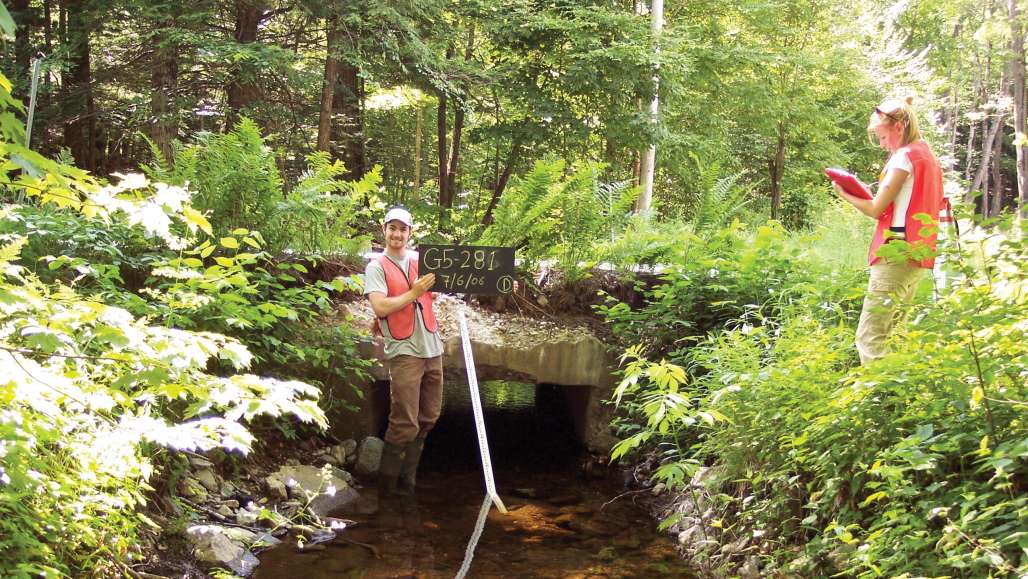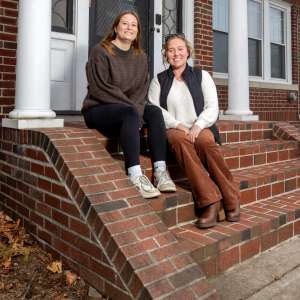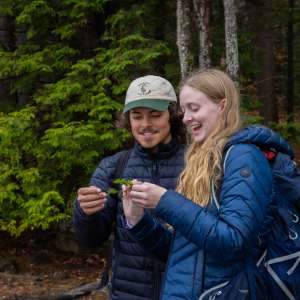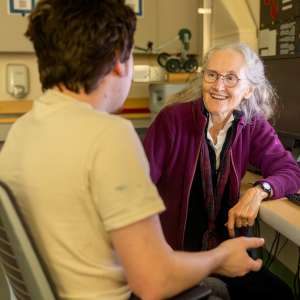Weaving a web of Science, Community and Conservation

With the mission of bringing together citizens and scientists to gather data aimed at protecting and restoring the local environment, educator David Moon founded Ashuelot Valley Environmental Observatory in 2003. In the early years, David ran the organization from his home in Westmoreland, but as the program grew, it needed a bigger, more public space. At the same time, Keene State was renovating its science center, re-envisioning it as a place where the college and the community could come together around science. Dean of Sciences Gordon Leversee saw AVEO’s work as “a nice fit with the kinds of experiences our faculty wanted for students – to be in the field, doing science that matters.”
From its base in the Putnam Science Center, AVEO launched community-based research projects, monitoring water quality, documenting vernal pools, and surveying fish passageways at road-stream crossings throughout the Ashuelot River watershed. Over the years, AVEO staff have engaged hundreds of volunteers, who join students at KSC for trainings. They have also served as mentors to students undertaking capstone research projects in geography, environmental studies, education, and biology.
AVEO expanded its mission in 2010 by becoming part of one of New England’s top environmental organizations – the Harris Center for Conservation Education in Hancock, New Hampshire. The Harris Center has a long history of large-scale land protection efforts and excellent environmental education programming, including an annual calendar of more than 100 free public programs and guided outings. Linking with the Harris Center enabled AVEO’s collaboration with Keene State to expand beyond volunteer training and into other programming with a conservation science focus.
Under the aegis of the Harris Center and AVEO, the KSC School of Sciences co-sponsors monthly public programs on conservation science. Recent programs have included presentations of local graduate student research on the migration of Northern Saw-whet Owls, an Antioch University New England professor who engages high school students in studying the ecosystems atop Mt. Monadnock, and a series of powerful documentaries.
AVEO spins a wide web of joint efforts, connections with inestimable benefit, including advantages for KSC faculty and students. Dean Leversee observed that when students are doing important work for AVEO and its partner organizations, “the students feel a little more accountable than they do to faculty in regular classwork.
The Keene Vernal Pool Project
Vernal pools are small, temporary, forested ponds (“wicked big puddles” in the woods) that serve as breeding habitat for amphibians. Because they often dry up by late summer, they are easily overlooked in land-use planning and consequently lost to development. To help protect this habitat, AVEO trains volunteers to identify and document vernal pools, focusing on lands where information is needed for conservation planning. This project is still ongoing, but last summer AVEO staff presented an initial, interactive online map of documented and potential vernal pools to the Keene Conservation Commission, which lauded it as a valuable tool for protecting important habitat.
Many hands are making the project a success. Keene State students and faculty have collected data from Robin Hood Park, Goose Pond Forest, and many other acres of city-owned land. Their efforts continue, alongside members of the Keene Conservation Commission and graduate students from Antioch, as well as other community volunteers and local nature lovers. Enhancing the project’s usefulness, a team of geography education majors recently developed a middle-school curriculum on vernal pool mapping, informed by the Vernal Pool Project trainings and materials.
The Culvert Project
Joining forces with the Nature Conservancy, AVEO trained and coordinated more than 80 volunteer “Culvert Operators,” including several teams of KSC students, who surveyed nearly 1,000 culverts and bridges throughout southwest New Hampshire in 2006 and 2008 to determine where fish passage is most affected by road structures. A team of KSC geography seminar students conducted an analysis of the Black Brook culverts that was so impressive it prompted the Nature Conservancy to refine its own model for prioritizing areas for stream restoration. A team of geomorphologists, fish biologists, and other conservation scientists from Trout Unlimited, the Nature Conservancy, New Hampshire Fish & Game, and Antioch, are now reviewing photos and data collected by AVEO’s culvert volunteers. When the restoration projects are complete, they will combine to re-open more than 22.5 miles of upstream habitat for brook trout and other fish species.
Salamander Crossing Brigades
Every spring, as the rains drench New Hampshire, thousands of spotted salamanders, Jefferson salamanders, wood frogs, and spring peepers make their way to vernal pools to breed. When weather conditions align, this migration happens during just a few warm, rainy “Big Nights.” In some places, the amphibians’ journeys take them across busy roads, where they’re run over by cars in great numbers. AVEO trains Salamander Crossing Brigade volunteers – KSC students, Antioch students, and many local folks who come back year after year, simply for the joy of it all – to count migrating amphibians and to safely usher them across roads at amphibian-crossing hotspots. In the last five years alone, AVEO’s Salamander Crossing Brigade volunteers have crossed nearly 12,000 amphibians. In Keene, these data also led to the purchase of a parcel of conservation land – previously slated for development – as an important migratory amphibian corridor.
In the coming years, AVEO will continue its work training new volunteers, collecting more data, and sharing it with the Keene Conservation Commission, local land trusts, and other regional conservation decision-makers, giving the students’ work life beyond a shelf in a professor’s office.
Ashuelot Valley Environmental Observatory offices are now in the Carroll House on the KSC campus. Brett Amy Thelen is AVEO’s Program Director.





